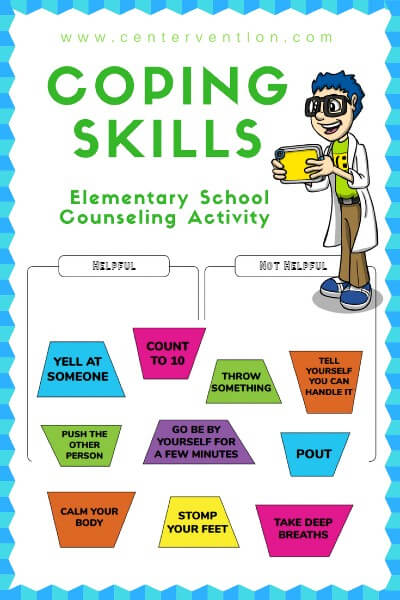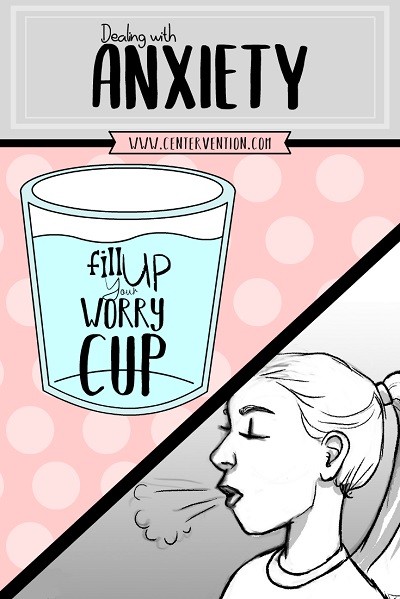Coping skills are essential for navigating the ups and downs of life. Whether we face major life changes, unexpected challenges, or just everyday stressors, having effective coping strategies can help us manage our emotions, reduce anxiety, and maintain a sense of control.
With the coping skills worksheets below, your students will have an opportunity to:
- Evaluate possible skills and determine if they would be helpful or not helpful
- Practice a technique called Square Breathing
- Take a specific problem and decide if how they are feeling is supported by facts
Coping skills come in many forms, including physical activities, mindfulness practices, social support, and cognitive techniques. By building a diverse set of coping skills and using them regularly, we can enhance our mental health and well-being, and improve our ability to handle whatever life throws our way.
Coping Skills Worksheet: Evaluating Strategies
Recommended Grade Level: Elementary
SEL Skill(s): Emotion Regulation
Duration: 30 minutes
Materials:
- Coping Skills worksheet
- 2 Sticky notes for each student
- Pencil, pen, or computer

Instructions
Using this worksheet, your students will evaluate a list of ten ideas and decide which ones will be helpful and which ones will not be helpful.
Provide a copy of the worksheet to each student and ask them to sort the ideas for calming down into two columns: Helpful and Not Helpful.
They can write, type, or cut-and-paste each of the ideas from page two of the worksheet.
Discussion
After your students have completed the worksheet, have a group conversation about the ideas they decided were Helpful and the Not Helpful.
Acknowledge that we all may have behaviors that we use right now that are Not Helpful, and ask them to write down, on a sticky note, one thing they do that they would like to change. Then have them write down an idea from the Helpful column that they could use as a replacement.
For the idea they wrote from the Not Helpful column, ask them to wad up that sticky note and throw it in the trash. Tell them they are done with that one and to replace it with the idea from the second sticky note. Have them place the second sticky note somewhere they can easily see it.
Extra
Have students use our free, virtual Cool Down Corner and make it clear to students that they are free to use it.
Coping Skills Worksheets For Anxiety
We’re sure you’re seeing a lot of students dealing with feelings of anxiousness and worry, and it may be difficult to know how to help, especially if you’re trying to cope with your own worries.
With the anxiety worksheets below, you can assist your students by helping them identify the source of their anxiety and with coping strategies that can be used to deal with those feelings.
But since anxiety looks a lot different for students in elementary school versus students in middle school, we have created two separate lessons, and both lessons are available as PDF worksheets.
Recommended Grade Level: Elementary and Middle
SEL Skill(s): Emotion Regulation
Duration: 30 minutes
Materials:

Worksheet for Elementary Students
In this lesson students will identify issues that bring on anxiety using a writing activity, and learn about square breathing as a tool to help them cope.
Prep: Print worksheets for your students and hand out the first one titled “Fill Up Your Worry Cup”
Prompt: Let your students know that we all have things we worry about. You may want to share a personal example of something you are worried about. Explain that feelings of worry can creep up on us, but talking about those feelings with others can often make us feel better.
Say, “Let’s take a few minutes to write down a few things that you are worried about”
Give the students some writing time
After students have completed the writing assignment, discuss examples as a class or in small groups.
Next: Hand out the square breathing worksheet. Review the instructions with students and do the exercises together as a group. Explain that this breathing technique is a tool in our toolbox that we can take out when we feel anxious or worried.
Worksheet for Older Students
In many cases, anxiety begins with thoughts of being embarrassed or judged for something that hasn’t even happened. And these thoughts can escalate into bigger worries to the point of feeling out of control. This lesson helps your students unpack and identify thoughts that may be causing worry or anxiety.
Prompt: Our thoughts are closely linked to our emotions and when there is something on our mind that we’re worried about, we may feel anxious or uneasy.
Today we’re going to write down something that we may be worried about. This can be completely private and you do not need to share it with anyone, this exercise is for you.
Then, we’ll break down our thoughts to help figure out if our worry is based on feelings or actual facts.
*Give the students time to write*
Use the questions below to examine and break down the thought. Ask yourself:
- “Is my thought based on a feeling or a fact?”
- “Is it possible for my thought to come true?”
- “What’s the worst that can happen if it does come true?”
- “Will it still matter to me tomorrow or in the future?”
- “What can I do to handle the situation in a positive way?
Prompt: Explain that by asking these questions, we will discover that we have the power to control how we feel about thoughts that creep into our mind. With this power, we can calm down and come back to a place where we feel in control.
The answers to the questions will show students that most of the time, whatever they are thinking can be broken down to a point where they can feel better about what is causing them to feel anxious.
In addition to the strategy above, there are a couple of additional coping strategies provided on page two of their worksheet.
Additional Resources
Books
- Breathe Like a Bear: 30 Mindful Moments for Kids to Feel Calm and Focused Anytime, Anywhere by Kira Willey and Anni Betts
- Little Monkey Calms Down (Hello Genius) by Michael Dahl and Oriol Vidal
- The Way I Feel by Janan Cain
Related Lessons
- Calm Down Corner
- Belly Breathing for Kids
- Feelings Wheel
- Parent Resource: Coping Skills for Gifted Students